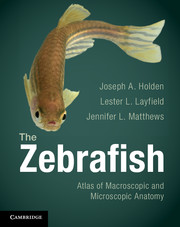Book contents
- Frontmatter
- Contents
- Preface
- Acknowledgments
- Chapter 1 Introduction
- Chapter 2 Cross section and longitudinal section atlas
- Chapter 3 Integument (skin)
- Chapter 4 Digestive system
- Chapter 5 Respiratory system
- Chapter 6 Circulatory system
- Chapter 7 Liver and gallbladder
- Chapter 8 Pancreas
- Chapter 9 Endocrine organs
- Chapter 10 Kidney
- Chapter 11 Reproductive system
- Chapter 12 Sensory systems
- Chapter 13 Central nervous system
- Chapter 14 Miscellaneous structures
- Chapter 15 Musculoskeletal system
- Index
- References
Chapter 15 - Musculoskeletal system
Published online by Cambridge University Press: 05 February 2013
- Frontmatter
- Contents
- Preface
- Acknowledgments
- Chapter 1 Introduction
- Chapter 2 Cross section and longitudinal section atlas
- Chapter 3 Integument (skin)
- Chapter 4 Digestive system
- Chapter 5 Respiratory system
- Chapter 6 Circulatory system
- Chapter 7 Liver and gallbladder
- Chapter 8 Pancreas
- Chapter 9 Endocrine organs
- Chapter 10 Kidney
- Chapter 11 Reproductive system
- Chapter 12 Sensory systems
- Chapter 13 Central nervous system
- Chapter 14 Miscellaneous structures
- Chapter 15 Musculoskeletal system
- Index
- References
Summary
Skeletal system
Zebrafish are bony fish whose skeleton is composed of bone and cartilage. Embryonically, most bone initially forms from a cartilaginous model and the skeleton is composed of both cartilage and ossified cartilage. Cartilage in its non-ossified state is firm but flexible as opposed to bone, which is hard and inflexible. Microscopically, cartilage is composed of a pale blue to purple stromal material (chondroitin sulfate) in which are dispersed large cells (chondrocytes) with pale or clear cytoplasm surrounding small central dark nuclei (Figure 15.1). Bone is composed of a pink, often lamellar, substance with small dark nuclei in lacunae and distributed along the edge (Figure 15.1).
In zebrafish, the skeletal system is most readily divided into the head and post-cranial skeletons. The components of the head skeleton are functionally interrelated and include the chondrocranium, the visceral skeleton, and the dermal bones of the integumentary skeleton. A predominant function of the head skeleton is to protect the brain and form an effective jaw. The integumentary skeleton is composed of bony scales that form just beneath the skin. The chondrocranium is part of the axial somatic system. The somatic skeleton is divided into the axial and appendicular components. The chondrocranium of the skull, the vertebral column, and the ribs, along with the median fins and sternum, are all components of the axial skeleton. The paired appendages and their component girdles (lateral fins) are portions of the appendicular skeleton. In fish as opposed to mammals, a visceral skeleton exists in the gut wall and forms skeletal arches associated with the pharyngeal pouches. Hence, mandibular arches, hyoid arch, and branchial arches all exist in fishes.
- Type
- Chapter
- Information
- The ZebrafishAtlas of Macroscopic and Microscopic Anatomy, pp. 134 - 143Publisher: Cambridge University PressPrint publication year: 2013



